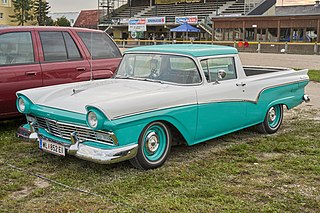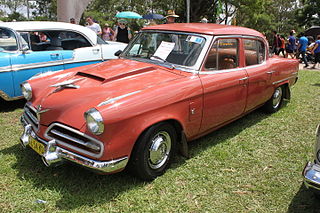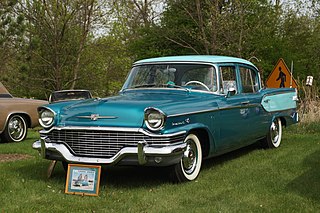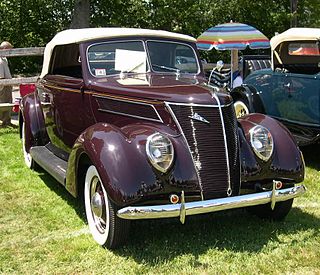
The Ford Anglia is a small family car that was designed and manufactured by Ford UK. It is related to the Ford Prefect and the later Ford Popular. The Anglia name was applied to various models between 1939 and 1967. In total, 1,594,486 Anglias were produced. It was replaced by the Ford Escort.

The Ford Ranchero is a coupe utility that was produced by Ford between 1957 and 1979. Unlike a standard pickup truck, the Ranchero was adapted from a two-door station wagon platform that integrated the cab and cargo bed into the body. A total of 508,355 units were produced during the model's production run. Over its lifespan it was variously derived from full-sized, compact, and intermediate automobiles sold by Ford for the North American market.

The Chevrolet Chevette is a front-engine, rear-drive subcompact manufactured and marketed by Chevrolet for model years 1976–1987 as a three-door or five-door hatchback. Introduced in North America in September 1975, the Chevette superseded the Vega as Chevrolet's entry-level subcompact, and sold 2.8 million units over 12 years. The Chevette was the best-selling small car in the U.S. for model years 1979 and 1980.

The Pontiac Catalina is a full-size, junior series automobile produced by Pontiac from 1950 to 1981. Initially, the name was a trim line on hardtop body styles, first appearing in the 1950 Chieftain Eight and DeLuxe Eight lines. In 1959, it became a separate model as the "entry-level" full-size Pontiac.

The Studebaker Golden Hawk is a two-door pillarless hardtop personal luxury car produced by the Studebaker Corporation of South Bend, Indiana, between 1956 and 1958.

The Dodge Monaco is an automobile that was marketed by the Dodge division of Chrysler Corporation. Introduced as the flagship of the Dodge product line, the Monaco was introduced for 1965 to replace the Custom 880, then later joining as a sub-model of the Dodge Polara. During its production, the Monaco was offered in multiple body configurations, including two-door and four-door hardtop sedans, four-door sedans, two-door convertibles, and station wagons.

The Buick Roadmaster is an automobile that was built by Buick from 1936 until 1942, from 1946 until 1958, and then again from 1991 until 1996. Roadmasters produced between 1936 and 1958 were built on Buick's longest non-limousine wheelbase and shared their basic structure with the entry-level Cadillac Series 65, the Buick Limited, and after 1940, the Oldsmobile 98. Between 1946 and 1957 the Roadmaster served as Buick's flagship.

The Daihatsu Compagno is an automobile which was produced by Daihatsu in Japan from 1963 to 1970. The name comes from the Italian word for "partner." The Compagno was designed to be offered in multiple bodystyles, and was introduced prior to the acquisition of Daihatsu by Toyota in 1967. The Compagno was available as a two-door sedan, four-door sedan, two-door pickup truck, a three-door delivery van and a convertible. The first Compagno prototype was shown at the 1961 Tokyo Motor Show and was of an appearance reminiscent of the Fiat 1800/2100. This was not a very well balanced design and Vignale's production version ended up looking quite different. The Compagno used a ladder-type chassis instead of the more modern monocoque style, with torsion bar wishbone suspension at the front and semi-elliptical leaf springs for the rear axle. The Compagno is also the first Daihatsu car to use the famous "D" logo.

The Studebaker Land Cruiser is an automobile that was produced by the Studebaker Corporation of South Bend, Indiana from 1934–1954. The Land Cruiser debuted at the World's Fair alongside the Silver Arrow, a product of Studebaker's former premium make Pierce-Arrow. It was also manufactured in Vernon, California.

The Studebaker Commander is the model name of several automobiles produced by the Studebaker Corporation of South Bend, Indiana and Studebaker of Canada Ltd of Walkerville and, later, Hamilton, Ontario (Canada). Studebaker began using the Commander name in 1927 and, with interruptions in 1936 and 1959-63, continued to use it until 1964. The name was applied to various products in the company's line-up from year to year. The Commander was the company's mainstream product, the Studebaker Champion was the junior model, and other models were short lived or renamed as market conditions required.

The Studebaker Champion is an automobile which was produced by the Studebaker Corporation of South Bend, Indiana, from the beginning of the 1939 model year until 1958. It was a full-size car in its first three generations and a mid-size car in its fourth and fifth generation models, serving as the junior model to the Commander.

The Studebaker Lark is a compact car that was produced by Studebaker from 1959 to 1966.

The Studebaker President was the premier automobile model manufactured by the Studebaker Corporation of South Bend, Indiana (US) from 1926 until 1942. The nameplate was reintroduced in 1955 and used until the end of the 1958 model when the name was retired.

The Studebaker Champ is a light-duty pickup truck produced by the Studebaker Corporation from 1960-1964, the last such vehicles designed by the company before leaving the automobile manufacturing business in 1966.

Transtar was the model name given to the line of pickup trucks produced by the Studebaker Corporation of South Bend, Indiana, from 1956-1958 and 1960-1963. The name was used on most trucks in the Studebaker E-series, but not all. The Transtar name was first introduced for the 1956 model year in 1/2-ton, 3/4-ton, 1-ton, 2-ton, and 2-ton heavy duty capacities. The three smaller models were available with factory-built pick-up bodies. The basic styling of these trucks dated back to the 1949 models, though they had received some styling and engineering changes in 1954 and 55. The Transtar name continued to be used on most of the 1957-58 3E series trucks, though a stripped-down Studebaker Scotsman model without the Transtar name was introduced in the 1958 model year. The 57-58 Transtars received an aggressive new fiberglass grille that attempted to make Studebaker's outdated cab design look fresh and new. For unknown reasons, the Transtar name was dropped for the 1959 4E series Studebaker trucks and changed to Deluxe.

The Packard Patrician is an automobile which was built by the Packard Motor Car Company of Detroit, Michigan, from model years 1951 through 1956. During its six years in production, the Patrician was built in Packard's Detroit facilities on East Grand Boulevard. The word "patrician" is Latin for a ruling class in Ancient Rome. It was the last "senior level" Packard until production ended in 1958.

The Edsel Ranger is an automobile that was produced and sold by the newly formed Edsel Division of Ford for the 1958–1960 model years. It was built on the shorter, narrower Edsel platform, shared with Ford and Edsel Pacer models.

The Ford Falcon is a model line of cars that was produced by Ford from the 1960 to 1970 model years. Though preceded by the Rambler American, the Falcon was the first compact car marketed by the Big Three American manufacturers.

The Ford line of cars was updated in 1937 with one major change — the introduction of an entry-level 136 cu in (2.23 L) V8 in addition to the popular 221 cu in (3.62 L) flathead V8. The model was a refresh of its predecessor, the Model 48 and was the company's main product. It was redesigned more thoroughly in 1941. At the start of production, it cost US$850. The Ford Line bore several model numbers during this period, each related to their respective HP numbers. In 1937, 85 HP cars were known as Model 78 while 60 HP cars were known as Model 74. This changed to Model 81A and 82A respectively in 1938, and Models 91A and 92A in 1939.

The TN360 and its successors in the long running TN series is a cab over pickup truck from Honda, which replaced the T360 in November 1967.






















